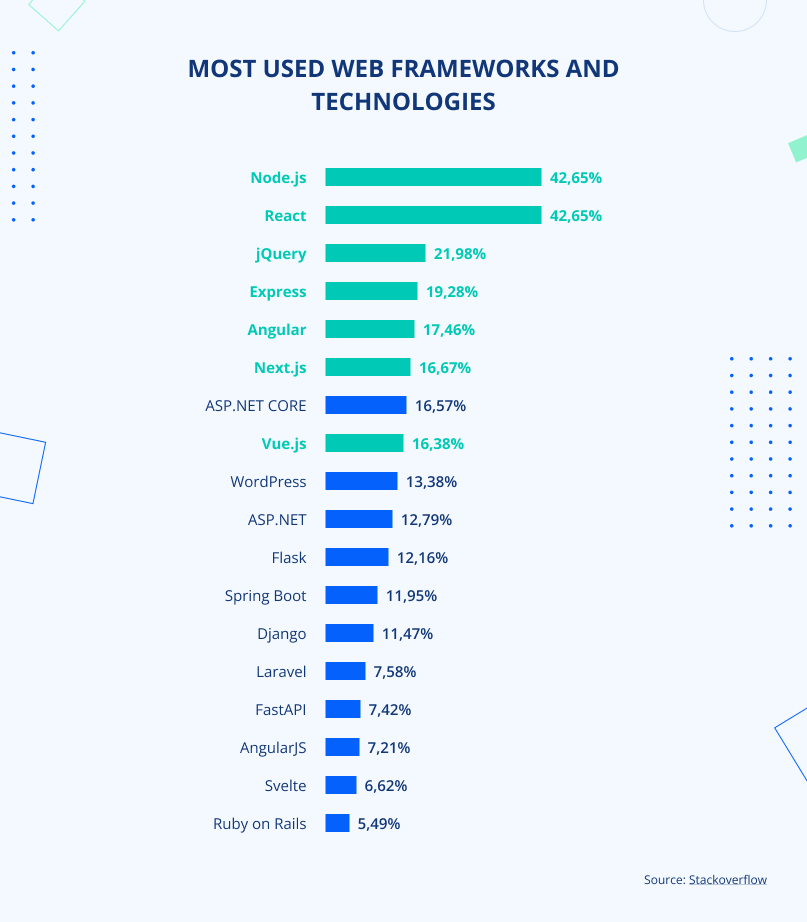News Blast: Your Daily Update
Stay informed with the latest news and trends.
JavaScript Frameworks: The Battle of the Titans
Discover the ultimate showdown of JavaScript frameworks! Uncover which titan reigns supreme in the world of web development!
Exploring the Giants: A Deep Dive into Popular JavaScript Frameworks
JavaScript frameworks have become indispensable tools for developers seeking to create dynamic and responsive web applications. Among the most popular frameworks, React, Angular, and Vue.js stand out due to their unique features and capability to enhance productivity. React, maintained by Facebook, excels with its component-based architecture that encourages reusable code and efficient rendering. Angular, developed by Google, provides a comprehensive solution, combining dependency injection, two-way data binding, and a robust set of built-in tools. Meanwhile, Vue.js offers a flexible approach, allowing developers to adopt it gradually as a library or utilize it as a full-fledged framework. Each of these giants facilitates a different development experience, catering to diverse project needs.
As we explore these frameworks further, we can highlight key aspects that make each of them suitable for various applications. React is particularly favored for its virtual DOM, which optimizes performance, while Angular stands out with its powerful CLI tools that simplify development processes. Vue.js shines with its simplicity and gentle learning curve, making it an excellent choice for newcomers as well as seasoned developers. Ultimately, selecting the right framework depends on project requirements, team expertise, and future maintenance considerations, making it essential to evaluate the unique advantages each framework offers.

React vs. Vue vs. Angular: Which Framework Reigns Supreme?
When it comes to modern web development, choosing the right framework can significantly influence the success of your project. In the battle of React vs. Vue vs. Angular, each framework offers unique advantages and challenges. React, developed by Facebook, is recognized for its flexibility and performance, thanks to its virtual DOM. It empowers developers to build user interfaces with ease. Vue, created by Evan You, is known for its simplicity and gradual learning curve, making it a great choice for beginners. On the other hand, Angular, backed by Google, is a full-fledged framework that provides a robust solution for enterprise-level applications, boasting extensive tools and features.
In deciding which framework reigns supreme, it ultimately comes down to the specific needs of your project. Here are some key factors to consider:
- Learning Curve: If fast onboarding is a priority, Vue may be your best bet.
- Performance: For high-performance applications, React could be the ideal choice due to its efficient updating mechanism.
- Comprehensive Solution: If you need a complete framework with robust testing, routing, and state management solutions, Angular shines in this area.
Ultimately, the choice between React, Vue, and Angular should align with your project goals and team expertise.
What Makes a JavaScript Framework Great? Key Features to Consider
When evaluating what makes a JavaScript framework great, several key features stand out. First and foremost is performance. A framework should be lightweight and optimized for speed to ensure fast loading times and a seamless user experience. Additionally, scalability is crucial; as applications grow in complexity, the framework must be able to support this growth without sacrificing performance. Other essential features include modularity, which allows developers to build applications in a more organized manner, and community support, where a strong ecosystem can provide libraries, tools, and shared knowledge to help developers overcome challenges.
Another important aspect lies in the developer experience. A great JavaScript framework should offer clear documentation, intuitive APIs, and robust tooling that facilitate rapid development. Moreover, consider the concept of reactivity, where the framework should efficiently manage changes to the application state while ensuring smooth updates to the user interface. Alongside these features, look for testing capabilities that enable developers to catch bugs early and maintain high code quality. Ultimately, the combination of these elements can significantly enhance productivity and lead to the creation of robust, maintainable web applications.